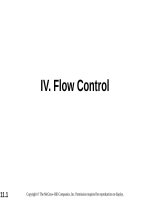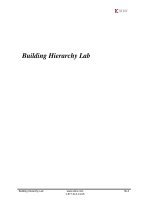ĐIỆN tử VIỄN THÔNG chapter 1 introduction to multimedia khotailieu
Bạn đang xem bản rút gọn của tài liệu. Xem và tải ngay bản đầy đủ của tài liệu tại đây (964.29 KB, 38 trang )
Multimedia Engineering
--------Lecture 1:
Introduction to Multimedia
Lecturer: Dr. Đỗ Văn Tuấn
Department of Electronics and
Telecommunications
Email:
My Principle is……
Teach less, learn
more
2
Possible research topics
Consider one of the following topics for
your graduation thesis
1. Machine fault detection and diagnosis in
power plants
2. Medical signal processing
3. Data mining
4. Watermarking
5. Computer vision
6. Speech processing
3
Course coverage
Topics
Number
of
lectures
Introduction to Multimedia
03
Fundamental of speech signal
processing
06
Video engineering
06
Basic of audio engineering
06
Lossless compression technique
06
Lossy compression technique
06
Presentation
12
Total
45
4
Grading policy
Estimation methods
Group project (presentations, reports)
30%
Final term
70%
Total
100%
5
Projects
1. Class is divided in to 10 groups
2. Choose the topics to work on
6
References
1. Fundamentals of Multimedia, Ze-Nian Li and Mark
S. Drew, Pearson Education International 2004.
2. Multimedia Communications: Directions and
Innovations, Jerry D. Gibson et al., Academic
Press, 2001.
3. Digital Video Processing, A. Murat Tekalp,
University of Rochester, Prentice Hall PTR.
4. Fundamentals of Digital Image Processing,
Anil.K.Jan, Prentice Hall, 1996. MPEG Home page,
5. />6. Principle of Speed coding, Tokunbo O., Madihally
N., CRC Press, 2010
7. Internet.
7
Lecture contents
1. What is Multimedia?
2. Multimedia and Hypermedia
3. World Wide Web
8
Definition of Multimedia?
Definition: the multimedia term can have many
definition, the good one is:
Multimedia is the field concerned with the
computer-controlled integration of text, graphics,
drawings, still and moving images (Video),
animation, audio, and any other media where
every type of information can be represented,
stored, transmitted and processed digitally
9
Multimedia Applications?
What is a multimedia application?
An application which uses a collection of multiple
media sources e.g. text, graphics, images,
sound/audio, animation and/or video.
In many areas: advertisements, art, education,
entertainment, engineering, medicine,
mathematics, business, and scientific research.
10
Multimedia Applications?
Examples
Education,
business: A
presentation using
Powerpoint. Corporate
presentations may
combine all forms of
media content.
In Medicine:
scanning, X-ray, EEG,
etc.
11
Multimedia Applications?
Examples
(continued)
In Training:
Photoshop, audio,
video applications
In entertainment:
Games
12
Multimedia Applications?
Examples
(continued)
Smart electronics
Augmented reality
13
Lecture contents
1. What is Multimedia?
2. Multimedia and Hypermedia
3. World Wide Web
14
History of Multimedia?
Newspaper: perhaps the first mass
communication medium, uses text, graphics, and
images.
Motion pictures: conceived of in 1830’s in order
to observe motion too rapid for perception by the
human eye.
Wireless radio transmission: Guglielmo Marconi,
at Pontecchio, Italy, in 1895.
Television: the new medium for the 20th century,
established video as a commonly available
medium and has since changed the world of
mass communications.
15
History of Multimedia?
1945 – Vannevar Bush wrote a landmark article
describing what amounts to a hypermedia
system called Memex.
1960 – Ted Nelson coined the term hypertext.
1968 – Douglas Engelbart demonstrated the OnLine System (NLS), another very early hypertext
program.
1969 – Nelson and van Dam at Brown University
created an early hypertext editor called FRESS.
1976 – The MIT Architecture Machine Group
proposed a project entitled Multiple Media –
resulted in the Aspen Movie Map, the first
hypermedia videodisk, in 1978.
1985 – Negroponte and Wiesner co-founded the
MIT Media Lab.
16
History of Multimedia?
1991 – MPEG-1 was approved as an international
standard for digital video – led to the newer
standards, MPEG-2, MPEG-4, and further MPEGs
in the 1990s.
1991 – The introduction of PDAs in 1991 began a
new period in the use of computers in
multimedia.
1992 – JPEG was accepted as the international
standard for digital image compression – led to
the new JPEG2000 standard.
1995 – The JAVA language was created for
platform-independent application development.
1996 – DVD video was introduced; high quality
full-length movies were distributed on a single
disk.
17
Multimedia and Hypermedia?
A hypertext system: meant to be read
nonlinearly, by following links that point to other
parts of the document, or to other documents.
Hypermedia: not constrained to be text-based,
can include other media, e.g., graphics, images,
and especially the continuous media – sound and
video. The World Wide Web (WWW) – the best
example of a hypermedia application.
Hypermedia is also considered as one of
multimedia
Multimedia
is theapplications.
field concerned with the computer
controlled integration of text, graphics, drawings, still and
moving images (Video), animation, audio, and any other
media where every type of information can be
represented, stored, transmitted and processed digitally
18
Multimedia and Hypermedia?
19
Lecture contents
1. What is Multimedia?
2. Multimedia and Hypermedia
3. World Wide Web
20
World wide web
The W3C has listed the following goals for the
WWW:
Universal access of web resources (by
everyone everywhere).
Effectiveness of navigating available
information.
Responsible use of posted material.
History of WWW:
1960s- Charles Goldfarb et al. developed the
Generalized Markup Language (GML) for IBM.
1986 – The ISO released a final version of the
Standard Generalized Markup Language
(SGML).
1990 – Tim Berners-Lee invented the
HyperText Markup Language (HTML), and21the
Hypertext markup language
(HTML)
HTML: a language for publishing Hypermedia on
the World Wide Web – defined using SGML:
HTML uses ASCII, it is portable to all different
(possibly binary incompatible) computer
hardware. The current version of HTML is
version 4.01 (5.0).
The next generation of HTML is XHTML – a
reformulation of HTML using XML.
HTML uses tags to describe document elements:
<token params>: defining a starting point,
< /token>: the ending point of the element.
Some elements have no ending tags.
Naturally, HTML has more complex structures and
can be mixed in with other standards.
22
Read yourself:
HTTP
XML
CSS
Dynamic web page
HTML editors
…
23
End of the lecture
-------------Next lecture: fundamental of speech
signal processing
24
Today’s Topic
Computer Vision









